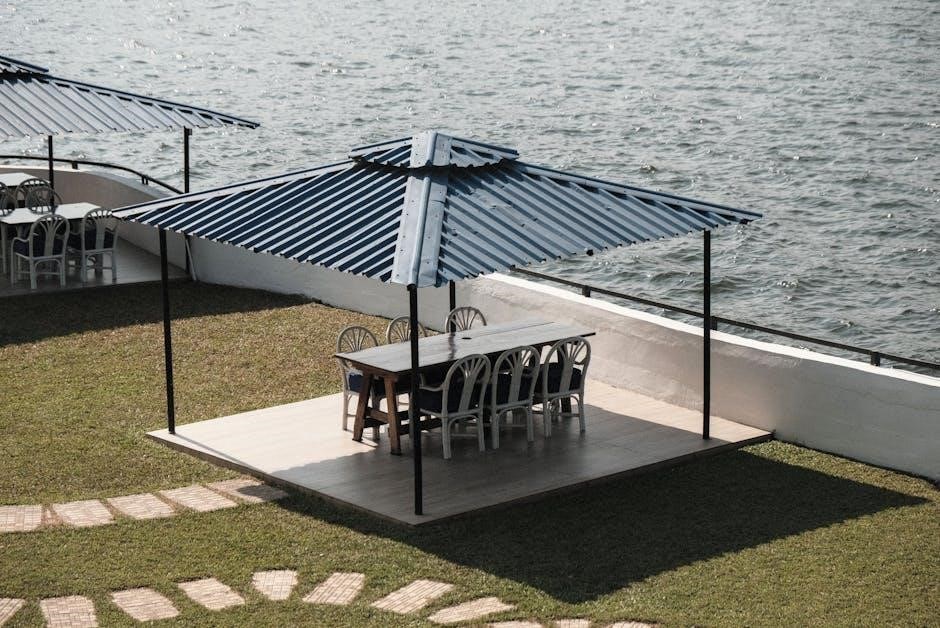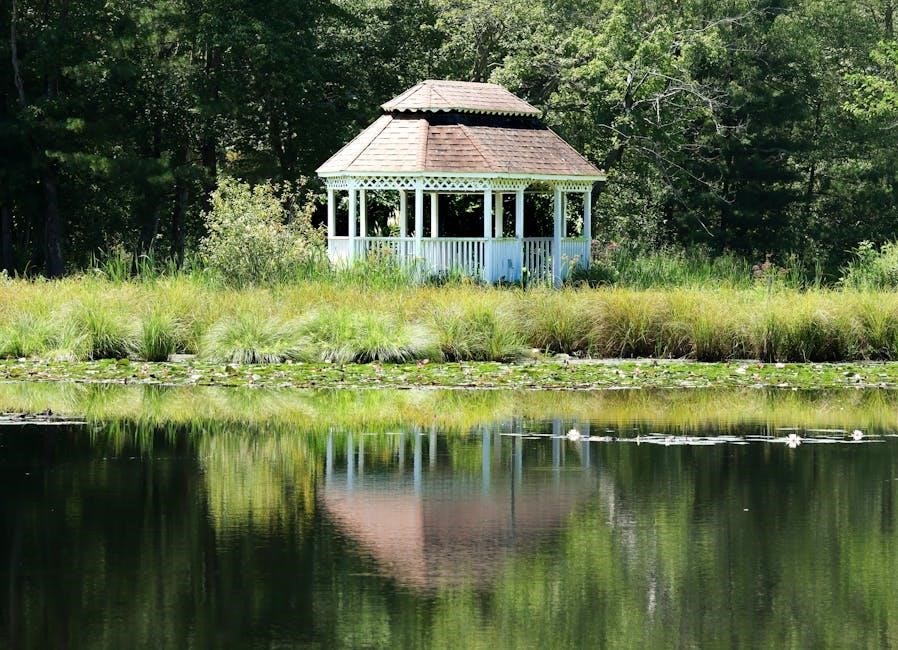10×10 gazebo assembly instructions

Welcome to the 10×10 Gazebo assembly guide. This guide provides a step-by-step walkthrough for assembling your 10×10 gazebo, ensuring a safe and enjoyable experience.
1.1 Overview of the Assembly Process
The assembly of a 10×10 gazebo involves a systematic approach to ensure stability and functionality. The process begins with unpacking and organizing all components, followed by assembling the frame, which forms the structural base. Next, the roof is installed, and support bars are attached to secure the canopy. The canopy itself is then carefully fitted and tightened to ensure a snug fit. Additional features like netting or shelves can be added for enhanced functionality. Finally, the gazebo is anchored to the ground for safety. Each step requires careful adherence to the instructions to avoid errors. The process is designed to be manageable with basic tools, though teamwork is recommended for larger components. Proper assembly ensures a durable and enjoyable outdoor structure.
1.2 Importance of Following Instructions
Adhering to the assembly instructions is crucial for the safe and successful construction of your 10×10 gazebo. Properly following the guide ensures all components are correctly aligned, reducing the risk of structural instability or damage. Skipping steps or ignoring safety precautions can lead to accidents, injuries, or premature wear of the gazebo. Clear instructions help avoid common mistakes, such as loose connections or improperly secured parts, which could compromise the integrity of the structure. Additionally, following the manual ensures compliance with safety standards and prevents issues like water pooling or leaks. Taking the time to thoroughly understand and follow each step guarantees a sturdy, functional, and long-lasting outdoor space for years of enjoyment.

Safety Precautions
Ensure a safe assembly process by following these guidelines: assemble on a clear, level surface, avoid inclement weather, and use proper tools to prevent accidents or damage.
2.1 General Safety Guidelines

Ensure a safe assembly process by adhering to these guidelines. Always assemble on a clear, level surface to prevent structural instability. Avoid assembling during heavy winds, rain, or extreme weather conditions. Use proper tools and avoid over-tightening components to prevent damage. Keep flammable materials away from the gazebo. At least two people are required for assembly due to the size and weight of components. Wear protective gear, such as gloves, to prevent injuries. Ensure the area is free from obstructions like branches or power lines. Follow all manufacturer instructions and safety warnings to minimize risks. Proper assembly ensures stability and longevity of your gazebo.
2.2 Required Tools and Materials
To successfully assemble your 10×10 gazebo, gather the following tools and materials: a screwdriver, wrench, hammer, measuring tape, and ladder. Ensure all hardware, such as bolts, screws, and washers, is included in the packaging. Check the parts list to confirm all components are present. Additional materials like a rubber mallet or drill may be useful for securing parts tightly. Refer to the instruction manual for specific hardware requirements. Organize tools and components before starting to streamline the process. Having a second person assist can help manage larger parts. Ensure the assembly area is clear and level to prevent complications. Proper preparation ensures a smooth and efficient assembly experience.

Unpacking and Inventory
Begin by carefully unpacking each box and cross-referencing items with the provided parts list. Organize components neatly to ensure all pieces are accounted for and undamaged. Verify hardware like bolts, screws, and washers are included to avoid delays during assembly. This step ensures a smooth process and helps identify any missing items early.
3.1 Checking the Parts List
Thoroughly inspect and verify all components against the provided parts list to ensure no items are missing or damaged. This step is crucial for avoiding delays during assembly. Carefully count hardware such as bolts, screws, and washers, as these are essential for securing the gazebo’s structure. Refer to the instruction manual for detailed descriptions and diagrams to identify each part accurately. If any items are missing or damaged, contact the manufacturer immediately to resolve the issue. Organize the components by category (e.g., frame pieces, roof parts, and hardware) to streamline the assembly process. Using a checklist can help track progress and ensure everything is accounted for before starting. This meticulous review ensures a smooth and stress-free assembly experience.
3.2 Organizing Components
Organizing components is essential for a smooth assembly process. Begin by laying out all parts on a clean, dry, and level surface. Use the parts list to categorize items into groups, such as frame pieces, roof components, and hardware. Place smaller items like screws, bolts, and washers into labeled containers or bags to prevent misplacement. Refer to the instruction manual for diagrams to identify each part accurately. Consider using a checklist to mark off items as you organize them. A well-organized workspace reduces the risk of losing parts and ensures efficiency. Additionally, label each group of components to make them easy to locate during assembly. This step saves time and minimizes frustration, allowing you to focus on building your gazebo successfully.

Assembly Process
The assembly process begins with constructing the frame, followed by attaching support bars and securing the canopy. Always refer to the manual for precise guidance.
4;1 Frame Assembly
The frame assembly is the foundation of your gazebo. Begin by unpacking and identifying all frame components, including the base, sides, and roof connectors. Refer to the manual for a detailed parts list and diagrams. Attach the frame tubes to the connectors, ensuring a secure fit. Use an Allen wrench to tighten all bolts firmly. Next, connect the side frames to the base, forming a square structure. Double-check that all corners are aligned and the frame is level. Once the base is assembled, move on to attaching the roof support beams. Always follow the step-by-step instructions in the manual to ensure accuracy. If unsure, consider enlisting a second person to assist, as some parts may be heavy or require additional support.
4.2 Roof Installation
After assembling the frame, proceed to the roof installation. Begin by attaching the roof support bars to the frame using the provided hardware. Ensure the bars are evenly spaced and securely fastened with an Allen wrench. Next, spread the canopy fabric evenly over the roof structure, aligning it with the pre-marked corners. Attach the canopy to the support bars using the straps or hooks provided. Tighten all connections firmly to maintain tension and prevent sagging. Refer to the manual for specific guidance on securing the canopy. If the gazebo includes netting, install it around the perimeter, ensuring it is tightly fitted. Double-check all roof components for stability before moving on to the next step. Always follow the step-by-step instructions to ensure a proper and safe installation.
4.3 Attaching Support Bars
Once the frame is assembled, focus on attaching the support bars. These bars are essential for stabilizing the roof and ensuring the gazebo remains secure. Begin by locating the pre-drilled holes on the frame where the support bars will be installed. Use the provided bolts and an Allen wrench to secure the bars tightly. Ensure the bars are evenly distributed and aligned properly to maintain structural integrity. If your gazebo model includes additional crossbars, attach them next, following the sequence outlined in the manual. Once all support bars are in place, double-check their tightness to prevent any shifting or instability. These bars also serve as anchor points for the canopy, so their proper installation is crucial. Always follow the step-by-step instructions to ensure a safe and sturdy assembly.
4.4 Securing the Canopy
After attaching the support bars, proceed to secure the canopy to the gazebo frame. Begin by aligning the canopy’s corners with the designated hooks or straps on the support bars. Use the provided Velcro straps or hooks to fasten the canopy tightly, ensuring it is evenly spread and free of wrinkles. Tighten the ropes or straps to eliminate any sagging, as this can lead to water pooling during rain. For added stability, ensure all connections are snug and double-check for any loose ends. If your model includes a center pole, attach the canopy’s center ring securely to prevent shifting. Once the canopy is in place, inspect it for proper fit and tightness to ensure it withstands wind and weather conditions effectively. Refer to the manual for specific attachment methods tailored to your gazebo model.

Additional Features
Enhance your 10×10 gazebo with optional features like netting, shelves, or storage solutions. These additions provide functionality and comfort, making your outdoor space more enjoyable and practical.
5.1 Installing Netting
Installing netting on your 10×10 gazebo is an excellent way to enhance its functionality and beauty. The netting provides protection from insects while allowing airflow and sunlight to filter through. Start by attaching the netting panels to the gazebo frame using the provided hooks or Velcro straps. Ensure the netting is tightly secured to prevent sagging or flapping in the wind. Begin at the top and work your way down, smoothing out any wrinkles as you go. Once installed, check all edges to ensure they are properly fastened. For added stability, tie the netting to the gazebo’s base using the included cords or straps. Regularly inspect the netting for tears or damage and clean it with mild soap and water to maintain its appearance. This feature adds comfort and style to your outdoor space, making it more enjoyable for relaxation or entertaining guests.
5.2 Adding Shelves or Storage

Adding shelves or storage to your 10×10 gazebo is a great way to maximize its functionality. Start by selecting pre-made shelves or storage units designed for outdoor use. Attach them to the gazebo’s frame using screws or brackets, ensuring they are level and secure. For a more custom look, consider installing floating shelves or storage cabinets. Always follow the manufacturer’s instructions for assembly and installation. Once installed, use the shelves to store items like cushions, decorations, or outdoor essentials. Adding hooks or bins can further enhance storage capabilities. Regularly inspect the shelves to ensure they remain stable and secure. This addition not only adds convenience but also keeps your gazebo organized and clutter-free, making it a more enjoyable space for relaxation or entertaining.
5.3 Optional Accessories
Enhance your 10×10 gazebo with optional accessories to customize its functionality and style. Consider adding netting for bug protection or lighting to create ambiance in the evening. Solar-powered lights or string lights are popular choices. For additional convenience, install shelves or storage cabinets to keep essentials within reach. Fans or ventilation systems can improve airflow, while decorative elements like plant hangers or wind chimes add a personal touch. Some gazebos also support curtains or sidewalls for privacy and weather protection. Always follow the manufacturer’s guidelines when installing accessories to ensure compatibility and safety. These additions can transform your gazebo into a more functional and enjoyable outdoor space, tailored to your needs and preferences.

Securing the Gazebo
Ensure your 10×10 gazebo is stable and safe by following proper anchoring techniques. Check that the structure is level and secure all connections firmly to withstand weather conditions.
6.1 Anchoring the Structure
Anchoring your 10×10 gazebo is crucial for stability and safety. Begin by ensuring the structure is placed on a level surface. Use anchor kits provided with the gazebo or purchase compatible ones. Typically, anchors are secured to the gazebo’s legs and embedded into the ground. Follow the manufacturer’s instructions for proper placement and tightening. Ensure all bolts and screws are tightened firmly to prevent movement. For added stability, consider weighting the structure or using ground stakes. Regularly inspect the anchors to ensure they remain secure, especially after heavy winds or rain. Proper anchoring will protect your gazebo from shifting or tipping, ensuring it remains safe and durable for years to come.
6.2 Tightening All Connections
Tightening all connections is a critical final step in securing your 10×10 gazebo. Use an Allen wrench or socket wrench to ensure all bolts, screws, and brackets are firmly tightened. Pay particular attention to the frame, roof supports, and any movable parts. Double-check the roof-to-frame connections, as these are key to maintaining structural integrity. Avoid overtightening, which could damage components, but ensure there is no movement or wobble in the structure. Repeat this process after the first use and periodically thereafter to account for any settling or loosening due to weather conditions. Properly tightened connections will ensure your gazebo remains stable and secure, even in harsh winds or rain. Regular checks are essential to maintain safety and longevity.

Maintenance and Care
Regularly clean the gazebo fabric and frame to prevent dirt buildup. Inspect for damage and tighten any loose connections. Store the canopy during harsh winter months to extend its lifespan. Always keep flammable materials away and avoid using harsh chemicals for cleaning. Follow manufacturer guidelines for any treatments or repairs to ensure longevity and safety.
7.1 Cleaning the Gazebo
Regular cleaning is essential to maintain the appearance and durability of your 10×10 gazebo. Start by brushing off loose debris from the fabric and frame using a soft-bristled brush. Mix a solution of mild detergent and warm water, and gently scrub the fabric with a sponge or cloth. Avoid using harsh chemicals or abrasive materials that could damage the material. Rinse thoroughly with a garden hose to remove soap residue. Allow the gazebo to air dry completely to prevent mold or mildew. For tougher stains or dirt buildup, repeat the cleaning process as needed. Inspect the roof and netting for any tears or damage during cleaning and address them promptly to ensure longevity.
7.2 Seasonal Storage Tips
Proper seasonal storage is crucial to protect your 10×10 gazebo from damage during off-season months. Before storing, disassemble removable parts like netting and shelves, and clean the structure thoroughly. Allow all components to dry completely to prevent mold or mildew. Store the gazebo in a dry, well-ventilated area, such as a garage or shed, away from direct sunlight and moisture. Use a sturdy storage bag or cover to protect the fabric and frame from dust and pests. Avoid storing heavy items on top of the gazebo to prevent bending or warping. Check for any damaged or worn parts before storage and address them to ensure the gazebo remains in good condition for future use. Secure the structure to prevent movement during harsh weather conditions.

Troubleshooting Common Issues
Address leaks by checking seams and applying waterproofing. For water pooling, adjust the roof slope. Tighten loose connections to ensure structural stability and prevent damage.
8.1 Leaks or Water Pooling
Leaks or water pooling on your gazebo roof can occur due to improper seam sealing, clogged drainage systems, or incorrect roof angle installation. Inspect the roof fabric for any tears or gaps, and ensure all seams are tightly sealed. Clean debris from the roof and gutters to prevent water accumulation. If water pools, adjust the roof frame to ensure a proper slope, allowing water to run off easily. Apply waterproofing treatments to the fabric and check for loose connections that may allow water infiltration. Regular maintenance and inspections can help prevent these issues, ensuring your gazebo remains durable and weather-resistant.
8.2 Loose or Damaged Parts
Loose or damaged parts can compromise the stability and safety of your gazebo. Regularly inspect all connections, bolts, and screws to ensure they are tightened securely. If you find any loose parts, tighten them immediately using the appropriate tools. For damaged components, such as bent frames or torn fabric, replace them with genuine manufacturer parts to maintain structural integrity. Avoid using the gazebo until repairs are made, as this could lead to further damage or collapse. Prevention is key; ensure all parts are properly aligned and secured during assembly, and perform routine checks after extreme weather conditions. Addressing these issues promptly will extend the lifespan of your gazebo and ensure it remains safe for use.
Congratulations! You’ve successfully assembled your 10×10 gazebo. Ensure all parts are secure and double-check for safety. Proper maintenance will extend its lifespan. Enjoy your new outdoor space!
9.1 Final Checks Before Use
Before enjoying your 10×10 gazebo, perform a final inspection to ensure all components are securely fastened. Check the roof for tightness, frame stability, and proper alignment of support bars. Verify that the canopy is evenly spread and free of wrinkles. Inspect netting for any tears or loose connections. Ensure all bolts, screws, and connectors are tightened firmly. Test the structure’s stability by gently shaking it to confirm no parts are loose. If you’ve added shelves or accessories, make sure they are secure. Finally, review the manufacturer’s guidelines for any additional checks. Once everything is confirmed to be in order, your gazebo is ready for use. Proper completion of these checks ensures safety and longevity of your outdoor structure.
9.2 Enjoying Your New Gazebo
Congratulations! Your 10×10 gazebo is now fully assembled and ready to enhance your outdoor space. Invite family and friends to relax, dine, or entertain under its sturdy canopy. Add decorative elements like string lights, cushions, or plants to personalize your space. For casual gatherings, set up a small table or outdoor furniture to create a cozy atmosphere. If you’ve installed netting, enjoy bug-free relaxation during warmer months. Regularly inspect and maintain the structure to ensure its longevity. Whether it’s a peaceful retreat or a lively hub, your gazebo offers endless possibilities for outdoor enjoyment. Make the most of your new space and cherish the moments it brings to your home.